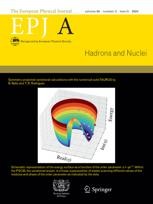Celebrating the impacts of Jacques Raynal’s work in the development of nuclear reaction formalism, codes and analysis
This topical article edition of EPJ A is dedicated to the memory of French nuclear physicist Jacques Raynal, who passed away on April 10th, 2020.
New York | Heidelberg, 12 November 2021
 It illustrates, through a series of peer-reviewed articles published in EPJA, the various facets of what Raynal and his colleagues accomplished, as well as the profound influence of his results in several domains of nuclear reactions, both for theory formalism and for the analysis and understanding of experimental observables. The articles also demonstrate how his work paved the way for the future development of concepts and numerical codes for nuclear reaction calculations.
It illustrates, through a series of peer-reviewed articles published in EPJA, the various facets of what Raynal and his colleagues accomplished, as well as the profound influence of his results in several domains of nuclear reactions, both for theory formalism and for the analysis and understanding of experimental observables. The articles also demonstrate how his work paved the way for the future development of concepts and numerical codes for nuclear reaction calculations.
In 1959, Jacques Raynal joined the Department of Mathematical Physics, which later became the division of Theoretical Physics (SPhT, now IPhT), at the CEA Saclay (Commissariat à l’Énergie Atomique), where he obtained his PhD (1964) and worked until his retirement in 1996. Afterwards he served as a scientific advisor to the CEA, while continuing his own scientific work. From a practical, technical and numerical standpoint, the nuclear reaction codes he elaborated (from his relativistic coupled channel code ECIS) were the foundations of a series of extended codes that are now used in laboratories around the world, and in particular at the IAEA in Vienna, for the calculation of nuclear data evaluations.
His whole life, which was intertwined with his scientific career until the end, was devoted to nuclear research. With his diligence, blend of curiosity and enthusiasm, and his rigorous mathematical language for physics problems, Jacques Raynal was the perfect combination: a theorist capable of addressing the fundamental questions of nuclear reactions and of making progress in solving problems of nuclear dynamics.
The articles in this issue highlight his global influence and the legacy of his work. The authors also pay tribute to how he interacted with his colleagues and the friendships he shared with them. He was invited by various international laboratories to teach on using his codes for the phenomenological analysis of experimental data. From Havana to Vienna and Bucharest, from Saclay and Hamburg to Tokyo, the sun never sets on the countless versions of the ECIS code now being used around the globe. All articles of the Topical Issue “A Tribute to J. Raynal”, are available here. For further information, please read the Editorial.
Reference: Alamanos, N., Bauge, E. & Lapoux, V. Jacques Raynal. Eur. Phys. J. A 57, 291 (2021). https://doi.org/10.1140/epja/s10050-021-00596-4
Further Information
For more information visit: www.epj.org
Services for Journalists
The full-text article is available here.
Contact
Sabine Lehr | Springer | Physics Editorial Department
tel +49-6221-487-8336 | sabine.lehr@springer.com
